There is a lot more to the Gauri-Ganpati festival fare than just modaks and motichoor ladoos. And, it's not necessarily sweet and vegetarian
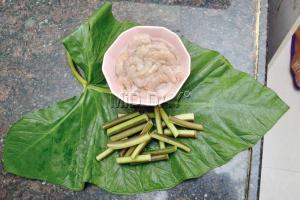
Maharashtra's 11-day Ganpati festival can be experienced through multiple prisms — Jhingat DJ music, dhol-tasha bands in the neighbourhood, Konkan-bound ST buses, school-college breaks, decorated pandals, clay idol workshops, designer backdrops, saree sales, mehendi combo discounts. But, if one were to rank-order the prime contexts characterising the festival in art, text, myth and ritual, the food cooked in the name of the Bappa and mother Gauri tops the chart. Food is energy and the most revered element of the collective worship when the favoured deity is a pot-bellied, elephant-headed, rotund dancer.
When he is not dancing, he is reclining against a pillow, with a loaded plate — he has to remove obstacles, initiate new beginnings, support academic advancement, and patronise the arts. No play begins without his invocation. Naturally, all this needs energy, lots of it. So, the Lord is happy to wallop 21 modaks (lest you forget that mod in modak denotes joy) at one go. He is no body worrier, priding on hyped-up six packs, but a super clever "dispenser of magic, surprise and laughter" (to quote culture critic Lee Siegel) whose girth is not to be concealed. As the myth goes, once the Moon laughed at his bulging belly and then paid a price for a lifetime. The angry Lord broke off one of his tusks and hurled it at the moon, which began waxing and waning ever since.
ADVERTISEMENT
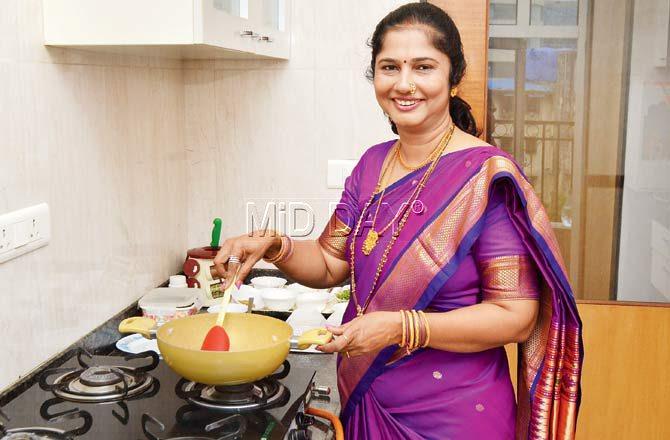
Smita Deepak Chaudhari, from the Somvashi Kshatriya Samaj, shops for fresh prawns ahead of the festival
Thankfully, in Maharashtra, no such mistakes have been made. There is adequate clarity about what the icon signifies, what he legitimises and the allowances he makes. In fact, there is a human bond with the relaxed foodie half-human form as seen in three all-time popular songs: Tashacha Awaz Tararara Zala Ani Ganpati Maza Nachat Aala; Ghungrachya Talavar Bappa Nache; Ala Nachat Ganraj. Which God comes, stays for 11 days, and then goes dancing every year with unfailing regularity, turning the Maximum City into a discotheque?
Obviously, good food offerings — bhog, annam, prasadam or naivedya play a primal part in the 16 upacharas or modes of worship in Indian tradition — remain key to the welcome for such an egalitarian, all-embracing deity. Mithai gifting speaks for the blanket acceptance of confectionaries (kaju modak, amba modak, steamed modak, chocolate modaks, mava peda) as a community-building medium in the season. Sweetmeats during meals is also a norm, as articulated in the famous Pralhad Shinde number — Hoto Varshane Ekda Harsh, Goad Annacha Hoto Re Sparsh. It's such a telling comment on the economically weaker sections of Maharashtra which look forward to Ganpati as a rightful access to sugar-based joys.

This, she cooks in a spicy curry saying her goddess, who symbolises the pampered married daughter visiting her mother's home, thrives on spice. Pics/Datta Kumbhar
But, mere confectionaries do not define the Lord's eclectic taste. He also revels in the green foliage, which is reflected in the commerce revolving around vegetables. The season witnesses a unique Ranbhaji festival in the tribal belt of Jawhar and adjoining villages where farmers showcase 20-odd recipes, made from unheard of tubers, kernels, wild fruits, flowering stalks, rhizomes, whose popular English names don't exist because they never make it to the urban Indians' plate. An NGO called Vayam organises the Ranbhaji taste fest merely to celebrate the nutritional richness of the leafy flora, which combats malnutrition.
Interestingly, even in urban areas, certain vegetables gain prominence only in the festive patch — like the poor man's kantoli (teasel gourd), pendhra (tamilnadia uliginosa), kadu kand (dioscorea balbifera), ambadi (gongura) and bamboo shoots. The Lord and Gauri mata are usually greeted with a notable rushi panchami veg-mix, served on the day after Ganesh Chaturthi. Yam, pumpkin, okra, snake gourd, ridge gourd, sponge gourd cooked with aloo (colocasia) and math (amaranth) leaves is a potent assortment, livened up by tamarind, chilies and desiccated coconut. The veggie wonders expand beyond imagination across castes and communities, named differently in varied regions like nau anyachi bhaji in Thane or ekvis bhajanchycha bhog in Nasik.
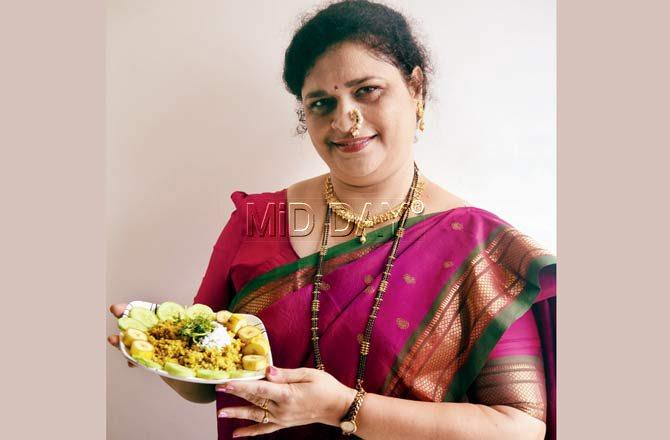
Thane resident Neha Nitish Bhusari remembers Gauri immersion back in her village for the naivedya of vadi made of soaked and melded gram flour, garnished with turmeric, mustard seeds and curry leaves. After the immersion, she says, the families would exchange the vadi with other womenfolk. Pics/Sameer Markande
The naivedya offerings in Vidarbha include the famous sola bhajyanchi bhaji which is prepared in honour of the Mahalakshmis — another form of Gauri who symbolises the married girls of the family who are to be served good food. As Nagpur-based Devyani Sandip Joshi, 45, observes, the 16 constituent veggies in the curry — peppers, gourds, spinach, potatoes, papaya, fava beans, and raw bananas, (the mix changes as per taste, but eliminating tomato, radish and eggplant) — is "a festival in itself" which puts enjoyable pressure on the Varhadi kitchens. In fact, a sorted bundle of 16 veggies is now vended in cities like Nagpur, so that women don't have to scout for greens. Needless to add, Bappa's cuisine adjusts to the exigencies of city life as well as region-specific crop patterns. For example, the tangy jowar flour coolant ambil served as naivedya in Vidarbha is made of rice or ragi in Konkan.
Naivedya offerings also adapt to changing social mores, as evident in the vadi made in predominantly Vaishya Vani homes. Thane-based Neha Nitish Bhusari, 46, recalls it as a delight prepared, in large portions, during Gauri immersion. Soaked and melded gram flour sparkles to a post-tadka green life garnished with turmeric, mustard seeds, and curry leaves. "An army of my kakis and aajis, along with two dozen children, used to carry the idol along with a huge steel container of Vadi Prasad to Wada's riverside.

After the ceremonial pooja and immersion, we would exchange the vadi with other womenfolk." There were slight variations in each families' Vadi delivery. Some added sliced cucumber and raw banana, to bring in the extra crunch. But what it essentially aimed and achieved was the fun-reunion of women and children. After marriage, Bhusari continues the Vadi tradition, on a smaller scale, as a festive standalone snack for her children and neighbours.
Unlike Bappa, who is usually served a vegetarian naivedya, goddess Gauri entertains 'meatier' experiments too. I visited two kitchens where sea food was part of the Gauri poojan prep. Andheri-based Smita Deepak Chaudhari, 48, belonging to the Somvashi Kshatriya Samaj (ancestral roots in Thane and Palghar) shopped for fresh prawns to be cooked in a spicy curry of blended onions, ginger-garlic paste, asafetida, scraped dry cononut, and colocasia stems. She says her goddess thrives on spice. "She also symbolises the mahervashin guest for us, the pampered married girl visiting her mother's home," chuckles Chaudhari. Many within her community give a twist to the same curry by wrapping-steaming the prawn in aloo leaves.
Thane-based Draupadi Harishchandra Koli, 70, is attuned to a different routine for her Gauri. The Koli family, earlier operating from Chendani Koliwada, keeps a close watch on the mud flappers (Nivti) which can be spotted only in low-tide muddy waters and sea creeks. She insists on the nivtiche kalvan, the spicy tamarind-tempered curry whose thickness comes from aloo leaves and stems.
"However difficult it is to spot nivtis, it is a joy we look forward to," she adds. Rich in calcium and high on taste, nivtis are usually caught alive. Often, the fluttering nivtis dangle out of shopping bags; some are so resilient that they spring to life even after being cut and placed on the pan. Like the Kolis, the Pathare Prabhus, the Chandraseniya Kayastha Prabhus, the Agris, and the Kasars also offer fish, mutton and chicken delicacies to the goddess. Homogenised or niche, proletarian or white-collar, sweet or savoury, large-scale or home-based, steamed or sautéed, Brahminical or Bhandari — Bappa and Gauri accept varied cuisines as devotees' labour. The devotees 'savour' the labour.
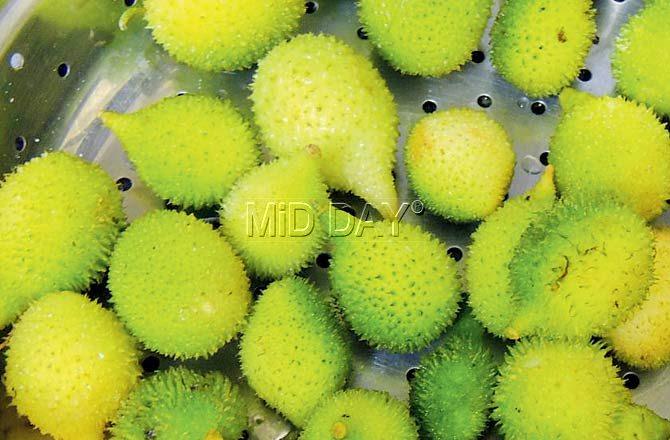
This season's veggies
Kantoli (teasel gourd, in pic), pendhra (tamilnadia uliginosa), kadu kand (dioscorea balbifera), ambadi (gongura) and bamboo shoots are the vegetables specific to this season. To make kantoli bhaji, choose a bunch of small, non-ripened green oval cute teasel gourd. Scoop out the seeds and cut them in a semi-circular shape, or leave them hollow after taking out the seeds. In a pan, heat oil, add mustard seeds, chopped onion and garlic cloves and turmeric. Sauté well, add kantoli slices and salt to the masala. After mixing, sprinkle water; cover and cook for around seven minutes. Some may add jaggery to moderate the bitterness. Serve hot, topped with coconut and chopped coriander.
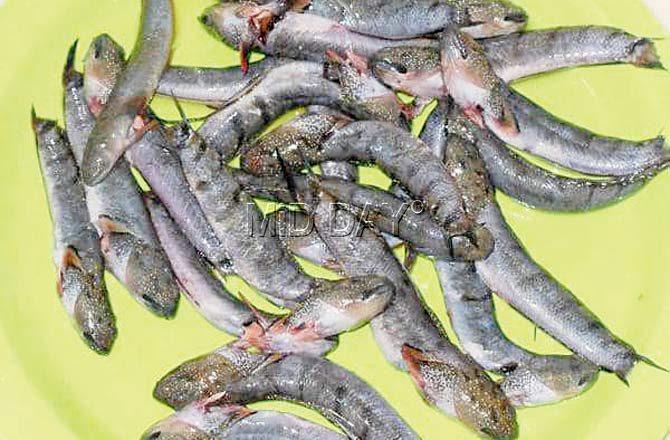
The Nivti recipe
Mud flappers or nivti are another popular offering in the Koli community. Thane-based Draupadi Harishchandra Koli prepares the nivtiche kalvan, the spicy tamarind-tempered curry whose thickness comes from aloo leaves and stems. The dish is offered to Gauri. Nivtis should be brought alive from the creeks or sea, and locked in a covered utensil, else they dangle out. The first step of the recipe is to sprinkle salt on the nivtis, and wash off the scales thoroughly. Blend green chillies, garlic cloves and ginger to make a fine paste for later use. Wash colocasia leaves and stems and cut them circular or otherwise. After heating the oil in a pan, add goda masala, salt and turmeric, tamarind paste as per taste and add the spicy paste. Put the washed colocasia, leaves and stems in the hot pan over the garnished oil. After the veggies are cooked in a covered pan, pour the cleaned nivtis, add water for a thick curry and cover the lid. Serve hot with bhakri or rice.
Sumedha Raikar-Mhatre is a culture columnist in search of the sub-text. She can be reached on sumedha.raikar@gmail.com
Catch up on all the latest Crime, National, International and Hatke news here. Also download the new mid-day Android and iOS apps to get latest updates
 Subscribe today by clicking the link and stay updated with the latest news!" Click here!
Subscribe today by clicking the link and stay updated with the latest news!" Click here!







